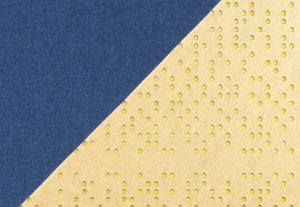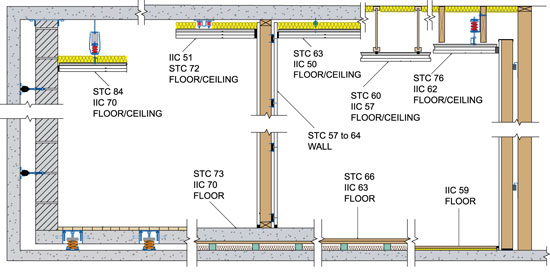Noise Control and Room Acoustics in Building Design
Sound reflection
Acoustical reflection is often desirable in critical listening environments versus the absorption and deadening of sound energy. Higher frequency sound reinforcement through early reflections off of the walls adds brilliance to music and improves speech intelligibility. Higher frequency sound is easily absorbed by common materials such as curtains, fabric covered chairs and people’s clothing. Designing a room to create a scattering of high frequency sound reflections is preferable and often required to prevent unwanted flutter echo. There are two types of sound reflection: Specular reflection and diffuse reflection.
Specular. Specular reflection is the mirror-like reflection of sound waves from a surface, in which sound from a single incoming direction is reflected into a single outgoing direction.
Diffusion. A diffuse sound field is designed to create uniform sound levels in all locations and from all directions. With adequate sound diffusion, each listener has the feeling of being “enveloped” in sound.
 |
A tuned absorber/diffuser panel acoustically optimizes the hole pattern in the laminate while maintaining the desired overall open versus reflective area in the panel surface. Photo provided by Kinetics Noise Control |
Compared to a reflective surface, which will cause most of the energy to be reflected off at an angle equal to the angle of incidence, a diffuser will cause the sound energy to be radiated in many directions, hence leading to a more diffusive acoustic space.
Over the years, manufacturers have developed many different diffusers for high performance facilities. They also offer panels that provide both absorption and diffusion:
Geometric-shaped diffusers break up direct sound reflections and disburse them more evenly throughout the listening space.
Quadratic residue diffusers invented in the 1970s by Dr. Manfred Schroedor diffuse sound in a predictable manner. Made from strips of wood material with different depths placed in sequence, their ability to diffuse sound evenly has long been tested and documented.
Adding reflection and diffusion Wall and ceiling panels are available that provide both absorption and diffusion where low and mid-frequency absorption is desired in conjunction with increasing reflectivity and diffusion in higher frequencies. A typical assembly is a sound absorptive fibrous core covered with a variable impedance laminate. Openings in the laminate are sized and spaced to optimize the absorption in lower frequencies while creating random mid and high frequency reflective surfaces between openings.
 |
Typical flooring, wall and ceiling STC and IIC values achieved through integrating acoustical products within framing designs. Illustration provided by Kinetics Noise Control |









